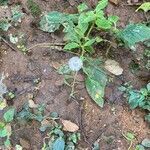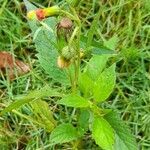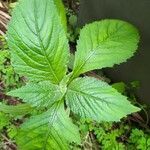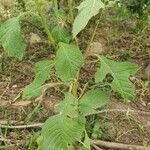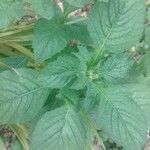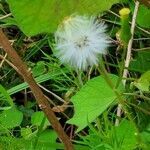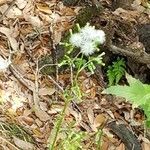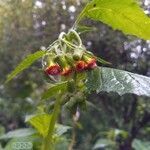Annual herb to c. 1.2 m high. Hairs moderately dense on most parts except leaves. Leaves to 20 cm long, with l: w ratio mostly c. 2–3, undivided or lobate to pinnatisect in proximal half; base petiole-like or sub-basal segments present; margins irregularly serrate. Inflorescence of few–several discoid capitula (capitula nodding at anthesis); mature peduncle to c. 40 mm long; calycular bracteoles 8–12, narrowly linear, 2–5 mm long; involucre 8–12 mm long, 3–5 mm diam.; bracts commonly c. 16, sparsely pubescent, becoming glabrous; stereome ±flat, with 1 or 2 inconspicuous resin ducts, with coarse hairs or glabrous; mature receptacle with pits strongly elevated. Florets numerous; corolla c. 10 mm long, exceeding involucral bracts by 2–3 mm, c. 0.2 mm diam. at base; limb c. 2/5 of total length, very narrowly obconical, orange to reddish brown (drying pink); style appendage purple. Achenes obloid-ellipsoid, 2.0–2.3 mm long, with c. 10 narrow convex ribs, purple, with scattered hairs in grooves. Pappus 8–14 mm long; bristles minutely and sparsely scabrid-barbellate.
Plants erect, 20-120 cm tall. Stems striate, glabrous. Leaf petiole 2-2.5 cm; blade elliptic or oblong-elliptic, 7-12 × 4-5 cm, membranous, both surfaces glabrous or subglabrous, base cuneate, margin irregularly serrate or double-serrate, sometimes pinnately lobed at base, apex acuminate. Capitula several to numerous in terminal corymbiform cymes, shortly pedunculate, 3-5 mm in diam. Involucres cylindric, 1-1.2 cm, basally truncate, with few unequal linear bracteoles; bracts of calyculus 6-21, 2-6 mm; phyllaries uniseriate, linear-lanceolate, equal, ca. 1.5 mm wide, margin narrowly scarious, apically puberulent. Florets tubular, bisexual; corolla red-brownish or orange, rarely yellow, 8-10 mm; lobes 5, ca. 1 mm. Style branches acute, papillose. Achenes brownish, narrowly oblong, 1.8-2.3 mm, ribbed, hairy. Pappus 7-13 mm, early deciduous. Fl. Jul-Dec.
An erect, thinly hairy, branching annual herb up to 1.2 m tall. Leaves alternate, up to 25 x 15 cm, elliptic to ovate in outline, tapering into a petiole up to 4 cm long with or without a pair of stipule-like lobes at the base, upper leaves entire or with a single lobe on either side at the base, lower sometimes lyrate-pinnatifid, margins coarsely and sharply serrate. Heads about 1 cm long, pedunculate, few to many corymbosely arranged, nodding at first, later erect. Involucral bracts c. 16, a little shorter than the flowers, more or less hairy. Flowers whitish or buff, the lobes reddish. Achenes c. 2 mm long, narrowly cylindric, ribbed, white-hispid between the ribs. Pappus of copious white hairs much longer than the achene, deciduous.
Erect, ± hairy, branching, annual herb, up to 1.2 m high. Leaves up to 250 x 150 mm, elliptic to ovate in outline, tapered petioles up to 40 mm long with or without a pair of stipule-like lobes basally, upper leaves ± entire, lower leaves sometimes lyrate-pinnatifid, margins coarsely, sharply serrate. Capitula ± 10 mm long, pedunculate, few-many in a corymb, nodding, then erect; involucral bracts ± 16, ± hairy. Flowering time Sept.-May. Cypselae 2 mm long, narrowly cylindric, ribbed; pappus of many long white hairs, deciduous.
A herb. An upright, annual plant about 1 m tall. The stem is thick and soft. The leaves are alternate and 16-18 cm long. The leaves have lobes, and have teeth around the edge. Sometimes the young leaves have a purple edge. The leaves often droop. A flower is yellow and reddish, and develops at the top, bending over at first, then becoming upright. Fluffy seed heads develop after flowering. The fruit is dark brown, with long, silky hairs at the end. The seeds blow in the wind.
Annual erect herb, up to 1.2 m high. Leaves entire or with 1 or 2 lobes at base. Peduncles with several to many heads. Flowers whitish or buff, lobes reddish.
Bright brownish-red florets in heads 1/3-1/2 in. long
A stout erect herb up to about 3 ft. high
